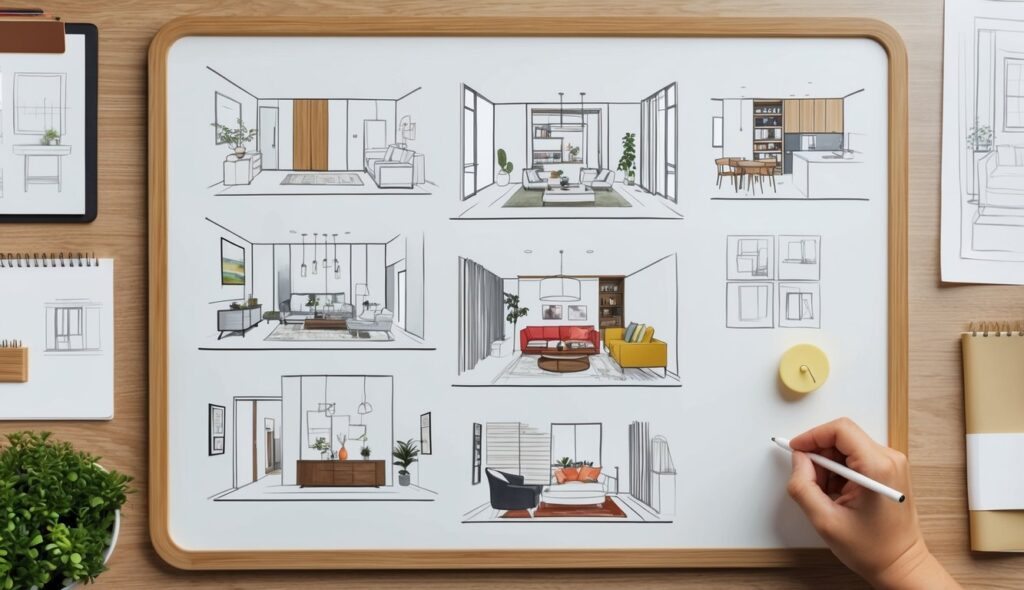Integrating technology into architecture has revolutionized how we approach design, efficiency, and comfort.
Remember to repin your favorite images!
Smart blinds are at the forefront of this shift, seamlessly blending functionality with modern aesthetics.
By integrating with home automation systems, these blinds not only enhance the look of a space but also optimize energy efficiency by adjusting based on natural light, occupancy, and time of day.
Architects can now strategically place sensors and automated systems to create intelligent environments.
These smart blinds can be synchronized with other smart home devices, creating a cohesive and responsive ecosystem.
For example, when combined with smart lighting, these blinds adjust to maintain optimal lighting levels while reducing energy consumption, showcasing a significant advancement in sustainable design.
The Intersection of Smart Technology and Architectural Design
Integrating smart technology with architectural design revolutionizes how spaces function and interact with their users. In particular, smart blinds illustrate the seamless blend of aesthetics, functionality, and sustainability.
Defining Smart Blinds and Their Role in Modern Architecture
Smart blinds are an essential part of modern architecture, offering automated control over light and privacy.
These blinds, like the dual-layer Keego Zebra Blinds, use both sheer mesh and opaque fabric slats, enabling optimized light management.
Architects incorporate these systems to enhance the user experience while maintaining design integrity and visual appeal.
Architects can place smart blinds strategically to work with natural light levels. This can reduce dependence on artificial lighting, thus promoting energy efficiency.
The ability to control blinds remotely or through automation aligns with the need for convenient, user-centric living environments.
Evaluating the Impact of Integrated Technology on Aesthetics and Functionality
The integration of smart technology into architectural design impacts aesthetics and functionality.
Advanced smart blinds harmonize with various design styles while providing practical benefits.
These blinds can be programmed to adjust based on the time of day, occupancy, and changes in natural light.
Combining technology with design enhances both form and function. It allows architects to create environments that are not only beautiful but also responsive and efficient.
The seamless appearance of smart blinds ensures they do not disrupt the overall design, but rather, complement it.
This synergy between aesthetics and technology achieves a sophisticated, modern look.
Exploring the Sustainability and Energy Efficiency Benefits
Architects are increasingly focused on sustainability and energy efficiency.
Smart blinds contribute to these goals by optimizing energy use.
Automated blinds can reduce reliance on HVAC systems by managing heat gain and loss. This promotes a more eco-friendly and cost-effective building.
Using smart blinds as part of an energy management strategy helps in maintaining indoor comfort while saving energy.
Systems that auto-adjust based on external conditions ensure that buildings use natural resources effectively.
Incorporating smart blinds into architectural designs supports the creation of sustainable, energy-efficient structures, aligned with contemporary eco-friendly architecture aspirations.
Technical Considerations and Implementation of Smart Blinds
Efficient and seamless integration of smart blinds in architectural design involves understanding their functionality, ensuring compatibility with smart home systems, and addressing security and privacy concerns.
Understanding the Function and Installation Procedures
Smart blinds use automated shading technology to manage natural light and reduce heat gain, enhancing comfort and energy efficiency.
These systems often include features like remote control, voice commands, and scheduling capabilities.
For proper installation, understanding the types and dimensions of window openings is essential.
This may involve selecting between corded, cordless, and motorized options.
Key considerations include wiring requirements, motor placement, and blending with existing home decor elements.
For example, motorized blinds can be integrated into HVAC systems to regulate indoor temperatures efficiently.
Smart Home Synchronization and Interconnectivity Challenges
Integrating smart blinds with existing smart home ecosystems can pose challenges related to device compatibility and interconnectivity.
Using technologies like Matter can ease these issues, ensuring smooth operation with other smart devices and systems.
When considering smart home synchronization, architects must account for different platforms like Apple HomeKit, Amazon Alexa, and Google Home.
Ensuring that smart blinds can communicate effectively with these systems is crucial for seamless automation.
Interconnectivity with other smart devices such as smart locks and surveillance systems can enhance overall home security and convenience.
Each device must be tested to confirm compatibility and reliable performance within the broader smart home ecosystem.
Addressing Security and Privacy Through Intelligent Design
Security and privacy in smart blinds design are crucial.
Ensuring that communication channels between blinds and control interfaces are secure helps protect against unauthorized access.
One must consider encrypted communication protocols and secure Wi-Fi connections.
For enhanced security, automated shading can be linked to home security systems, enabling blinds to close automatically when an alarm is activated.
Privacy is also enhanced by using smart technology to control blinds, providing quick and easy ways to obscure views inside the home.
Implementing these intelligent design principles ensures a blend of functionality and security in modern smart home environments.

